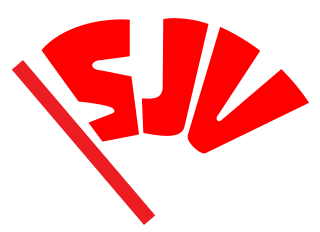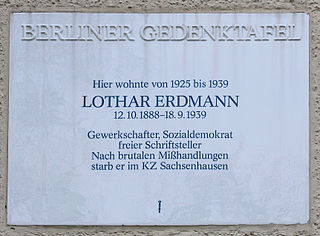Related Research Articles

The Free Workers' Union of Germany was an anarcho-syndicalist trade union in Germany. It stemmed from the Free Association of German Trade Unions (FDVG) which combined with the Ruhr region's Freie Arbeiter Union on September 15, 1919.
The German National Socialist Workers' Party was a protofascist party of Germans in Czechoslovakia, successor of the German Workers' Party (DAP) from Austria-Hungary. It was founded in November 1919 in Duchcov. The most crucial party activists were Hans Knirsch, Hans Krebs, Adam Fahrner, Rudolf Jung and Josef Patzel. In May 1932, it had 1,024 local chapters with 61,000 members.
Gustav Kessler (1832–1904) was a German trade unionist.
Svaz horníků v Československé republice was a miners trade union in the Czech Lands and later Czechoslovakia, affiliated to Odborové sdružení českoslovanské.

Wenzel Jaksch was a Sudeten German Social Democrat politician and the president of the Federation of Expellees in 1964 to 1966.
The Union of German Socialist Organisations in Great Britain was the amalgamation of German socialist and social democratic oriented organisations of exiled Germans during World War II.
The General German Trade Union Federation was a confederation of German trade unions in Germany founded during the Weimar Republic. It was founded in 1919 and was initially powerful enough to organize a general strike in 1920 against a right-wing coup d'état. After the 1929 Wall Street crash, the ensuing global financial crisis caused widespread unemployment. The ADGB suffered a dramatic loss of membership, both from unemployment and political squabbles. By the time the Nazis seized control of the government, the ADGB's leadership had distanced itself from the Social Democratic Party of Germany (SPD) and was openly cooperating with Nazis in an attempt to keep the organization alive. Nonetheless, on May 2, 1933, the SA and SS stormed the offices of the ADGB and its member trade unions, seized their assets and arrested their leaders, crushing the organization.

The Socialist Youth League of Germany was a youth organization in Germany. SJV was the youth wing of the Socialist Workers' Party of Germany (SAPD). SJV was founded in 1931. The organization was banned after the Nazi take-over 1933.
The General Commission of German Trade Unions was an umbrella body for German trade unions during the German Empire, from the end of the Anti-Socialist Laws in 1890 up to 1919. In 1919, a successor organisation was named the Allgemeiner Deutscher Gewerkschaftsbund, and then in 1949, the current Deutscher Gewerkschaftsbund was formed.
Schlesische Arbeiter-Zeitung was a left-wing German language newspaper published from Breslau, Province of Lower Silesia, Weimar Germany between 1919 and 1933.

Karl Hermann Dietrich Lothar Erdmann was a German journalist. During the Weimar Republic he was the editor of the trade union theory organ Die Arbeit. He was a main supporter of the turning away of trade unions from social democracy at the end of the Republic. Despite his rapprochement with National Socialism, he died after maltreatment in the Sachsenhausen concentration camp.
Reichsvereinigung der Deutschen Gewerkschaften was a trade union centre in the First Czechoslovak Republic. The organization had its headquarters on Krakovská street 11 in Prague. Initially the Reichsvereinigung grouped all the main German nationalist, or völkisch, trade unions in the Sudetenland. As of 1921, the affiliates of the Reichsvereinigung claimed to have 49,500 members. By the end of 1928, the organization claimed to have 51,500 members. The Reichsvereinigung was a supposedly apolitical body for German workers.
Verband deutscher Gewerkschaften was a German Nazi trade union centre in Czechoslovakia. The organization was formed in 1929, by eight unions that broke away from the Reichsvereinigung der deutscher Gewerkschaften. At the time of the founding of Verband deutscher Gewerkschaften, its affiliates claimed a combined membership of 46,700. The organization had its headquarters in Ústí nad Labem.
Bund deutscher Gewerkschaften was a German völkisch trade union centre in Czechoslovakia. The organization was founded in 1934. Politically it was linked to the German National Party. It had its headquarters in Tetschen. Its main union was the Deutsche Arbeitnehmergewerkschaft, Tetschen. D.A.N.T. had 6,278 members as of around 1934.
Between 1920 and 1936 miners in Czechoslovakia elected representative councils. Several different trade unions, representing various different political tendencies, contested the elections.
Jednota československých horníků a hutníků v Československé republice was a trade union in the First Czechoslovak Republic. As of 1929, the union claimed to have 5,893 members. The union had its headquarters in Most. It was affiliated to the Československá obec dělnická (ČOD) trade union centre. Politically, the union was tied to the Czechoslovak National Socialist Party.
Sdružení československých horníků was a Syndicalist mine workers trade union in Czechoslovakia.
Union der Bergarbeiter in der CSR, initially known as Union der Bergarbeiter Österreichs, was a miners trade union of miners in Austria and the First Czechoslovak Republic 1903–1938. Initially a multi-ethnic union in Habsburg Austria (Cisleithania), it was divided along ethnic lines in 1910. After the establishment of the Czechoslovak Republic, it became a union for miners of German ethnicity.
Národní sdružení odborových organizací was a trade union centre in the Czechoslovakia. Politically it was linked to the right-wing Czechoslovak National Democratic Party. The centre was organized by the former socialist Josef Hudec. As of 1929 organization was divided in 7 sections and had 304 branches.

The Central Union of Shoemakers of Germany was a trade union representing people working in the shoemaking industry in Germany.
References
- ↑ Hans Krebs (1936). Kampf in Böhmen. Volk und Reich Verlag. p. 172.
- 1 2 3 Ročenka Československé republiky. 1930. p. 246.
- 1 2 Zentralbibliothek der Gewerkschaften (1963). Protokolle und Berichte der Zentralbibliothek der Gewerkschaften: ein chronologisch gegliederter Bestandskatalog der Protokolle und Berichte der Arbeiter- und Gewerkschaftsorganisationen aus der Zeit vor 1945. Die Zentralbibliothek. pp. 68–69.
- 1 2 Reinhard Pozorny (1978). Wir suchten die Freiheit: Schicksalsweg der sudetendeutschen Volksgruppe. Verlag für Volkstum und Zeitgeschichtsforschung. p. 196.
- ↑ Keesings Archiv der Gegenwart. Berlin-Wilmersdorf. 1932. p. 1169.
- 1 2 Nationalsozialistisches Jahrbuch. Verlag Franz Eher Nachfolger. 1932. pp. 145–146.
- ↑ Leo Stern (1969). Archivalische Forschungen zur Geschichte der deutschen Arbeiterbewegung. Topos Verlag AG. p. 2055.
- ↑ Komunistická revue. J. Haken. 1928. p. 232.
- ↑ Ladislav Cabada; Zdenek Benedikt (14 September 2010). Intellectuals and the Communist Idea: The Search for a New Way in Czech Lands from 1890 to 1938. Lexington Books. p. 113. ISBN 978-0-7391-4378-0.
- ↑ Deutsche Arbeitsfront. Arbeitswissenschaftliches Institut (1938). Das Sudetendeutschtum, seine wirtschaftlichen, sozialen und geschichtlichen Grundlagen. Verlag der Deutschen Arbeitsfront GmbH. p. 35.
- ↑ Ročenka Československé republiky. 1931. p. 323.
- 1 2 Ullíková, Veronika. Mediální zobrazení Velké mostecké stávky
- ↑ Karl Sigmar Baron von Galéra (1940). Deutschlands Schicksalsweg, 1919-1939: Nachschlagewerk zur deutschen Geschichte. P. Hochmuth. p. 230.
- ↑ Jaroslav Šebek (2010). Sudetendeutscher Katholizismus auf dem Kreuzweg: politische Aktivitäten der sudetendeutschen Katholiken in der Ersten Tschechoslowakischen Republik in den 30er Jahren. LIT Verlag Münster. pp. 38–39. ISBN 978-3-8258-9433-7.